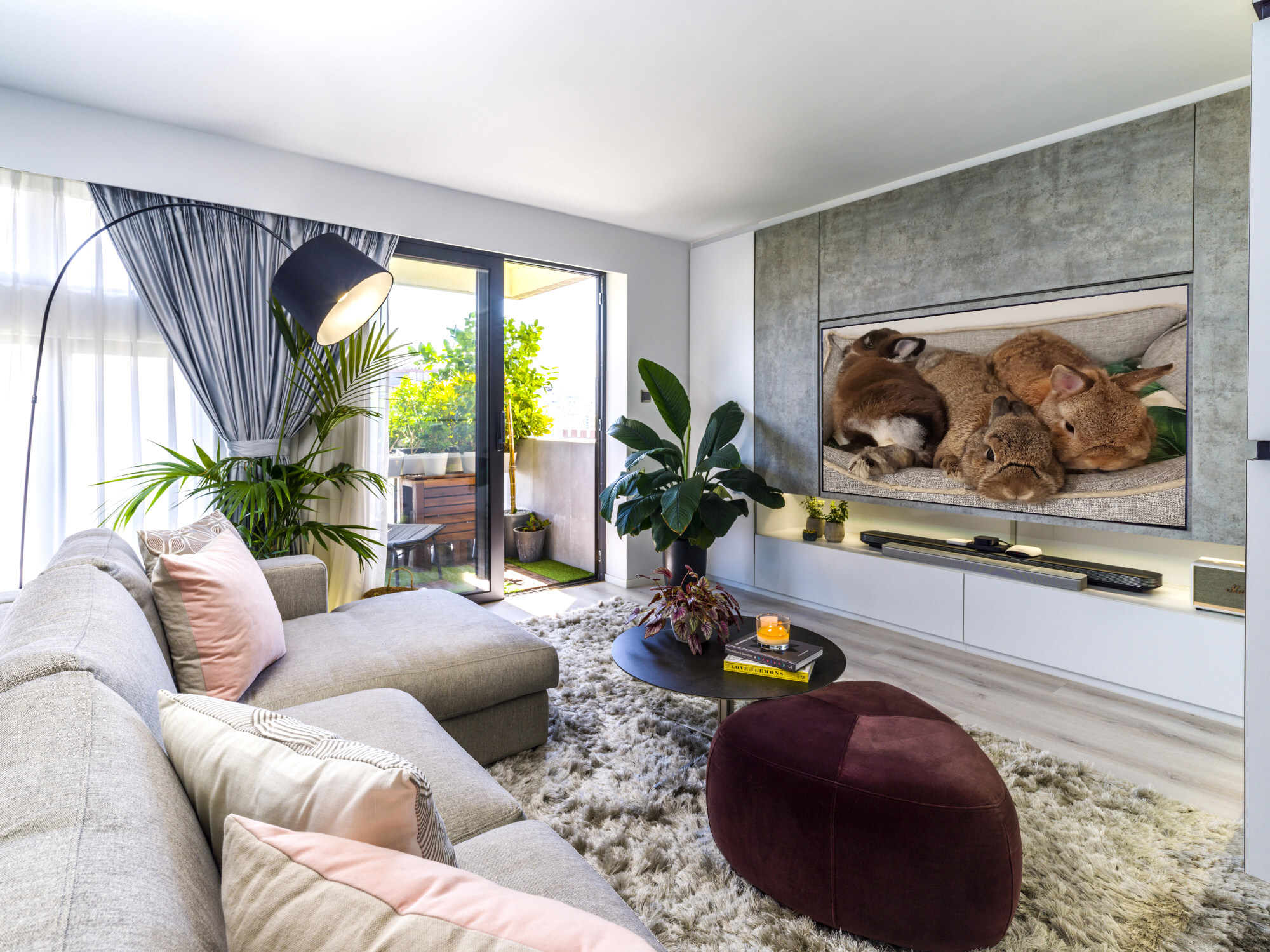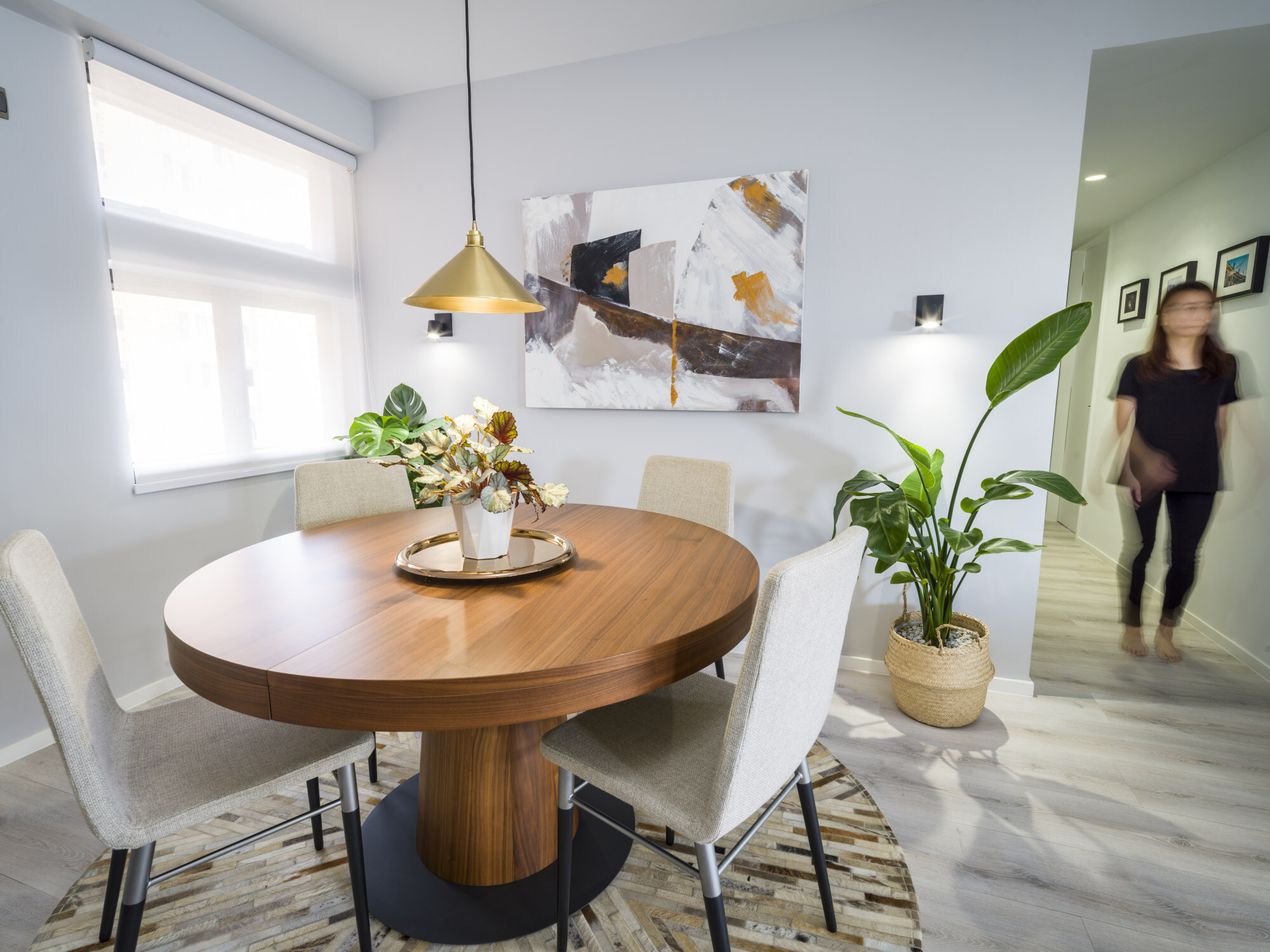
Three rabbits, a corgi and a young couple accommodated in Nordic style in a Hong Kong apartment bright with natural light and elegantly modern
- A young couple turned a gloomy, noisy and dark Hong Kong apartment into a tranquil, light-filled, contemporary home fit for them and their pets
- Decorated in whites and greys, functional and with lots of storage, it is bright by day and, thanks to smart lighting, a kaleidoscope of colour at night
High above King’s Park, in Kowloon, Hong Kong, a 1,300 sq ft (120 square metre) flat has been transported from its gloomy, noisy, 1970s origins to become a bright, tranquil and whisper-quiet, three-bedroom contemporary home for a young couple, their three pet rabbits and six-month-old corgi, Snowy.
The property has been in owner Tina Tsang’s family for decades. When she married her Google colleague Wilson Ng, it was overdue for a renovation.
“It was a family flat and it was always so dark – dark wood, parquet flooring, black wallpaper,” she says. “I have lived here for a long time, but when we got married, we wanted something completely different: light tones – white, grey, accents of black – and a Nordic style, but also functional with lots of storage. That was the most important thing for me.”
It turned out to be a dream brief for V Design founder and director Keith Chan, who was introduced to the couple through a mutual friend. Tsang and Ng had a few ideas for the flat – moving the entrance to the third bedroom, for example, and repurposing it as a study and an extension of the living space. Elsewhere, though, they were happy to let Chan take the lead.
Too many people ignore window insulation in Hong Kong. It’s made such a difference
“In all my designs, I like to reflect the owners’ personalities. Here, that meant modest elegance, comfort and structure,” Chan says. “I also injected influences from my architecture background – natural light, proportions, ‘simplexity’ and lightness of weight.”
That translated into a bright, clean-lined, open-plan living and dining space loaded with hidden storage behind white and grey concrete-effect panels. “Connecting and separating” the living room and entrance is a chunky white cabinet that “floats” on a black metal rod that appears too slender to support its weight.
Broad horizontal beams in the windows, which originally underpinned window-mounted air-conditioning units, also influenced the design. “It’s unusual to have these beams in the windows and led to a strong horizontal theme throughout the living space,” Chan says.
While the beams were retained, the windows were replaced with double-glazed units to reduce the noise from the busy road junction below.
“Too many people ignore window insulation in Hong Kong,” Tsang says. “It’s made such a difference.”
Penthouse fuses Japanese design with Scandinavian furniture
But the main change was to the kitchen. “It was not good planning before: the space was split between three small rooms – kitchen, maid’s toilet and a store room – and it was very dark,” Chan says. He reconfigured the space to create a much larger square kitchen, with a laundry and store room tucked away behind a semi-transparent wall of sliding doors and windows (see Tried + tested).
The material he chose – panels of fluted glass encasing an interlayer of fabric, mounted in a black metal frame – became a signature of the design. Similar panels are also used in the kitchen door, which disappears neatly into a pocket in the dining-room wall, and in a wall of windows and sliding doors between the study and living room. Its shiny, textured surface helps to bounce light through the flat and creates a glamorous contrast to the matt walls and built-in units.
While the flat is decorated predominantly in Nordic shades of pale, a few dark elements – such as grey feature walls in the study, main bedroom and entrance – add contrast and depth. In the two bedrooms, cosy textures and warmer colours, including copper hardware, a deep-pile rug, and natural leather details on the bedside tables, soften the otherwise cool palette.
A natural marble “beauty bar”, atop a bespoke set of drawers that separates the dressing and sleeping areas in the main bedroom, is a touch of luxury.
Smart lighting throughout the flat is controlled via an app, allowing Tsang and Ng to switch up the mood from their smartphones: cool white light by day, warmer tones at night or a kaleidoscope of blue, green and pink just for fun. Philips Hue light strips attached beneath the sofa and bench, behind the sideboard and under the cabinets add drama to the lighting, and enhance Chan’s illusion of floating and “lightness”.
The ultimate Hong Kong man pad – a light-filled 440 sq ft
But what really brings the scheme to life, of course, are the couple themselves, their pets and the many plants Ng has been cultivating throughout the pandemic.
“He’s even been growing some on the window ledge,” Tsang says, adding with a shrug: “That’s Covid.”

Living room
Owners Tina Tsang and Wilson Ng are big fans of furniture by BoConcept (boconcept.com), where over the years they acquired their sofa, coffee table, pouffe, rug and floor lamp. The cushions were bought years ago from Indigo Living (indigo-living.com) and Lane Crawford (lanecrawford.com.hk).
The balcony chair was a Taobao purchase (taobao.com). On the screen are the couple’s rabbits. (Taobao is a unit of Alibaba, owner of the South China Morning Post.)

Study
A wall-length desk in the former third bedroom, now a study, has space for two people to work and three rabbits to sleep. (“One of the rabbits doesn’t get on with the other two, so he usually sleeps in the utility room,” Tsang admits.)
The desk was designed by Keith Chan of V Design (vdesign.asia) and custom made by Chun Wun Engine (8/F, Block A, 19 Fung Kam Street, Yuen Long, tel: 2361 3301). The HAG Capisco office chairs were from Ekobor (ekobor.com.hk) and the Popocola rabbit beds and planter were found on Taobao.

Entrance
Dividing the living room and entryway, appearing to float above a low-slung set of drawers, is a substantial white cabinet apparently supported by only a slim metal rod (unseen). Chan designed the cabinet, drawers and mirror, which were custom made by Chun Wun Engine. The Oak Askada white-limed laminate flooring was by Parador and came from Pacific Flooring (309 Lockhart Road, Wan Chai, tel: 2710 9018). The ceiling light was from Ty Lighting (tylightinghk.com).

Dining area
The artwork in the open-plan dining area was painted by Tsang and Ng. “We didn’t know what to buy, so we painted our own … it took about four hours,” Tsang says. “We worked with a friend who is really good at art and was our guide during the whole process.”
The dining table was from BoConcept and the chairs and basket, used as a planter, came from Ikea (ikea.com.hk). The hide rug and brass pendant lamp were from Staunton and Henry (stauntonandhenry.com).

Kitchen
The concrete-effect wall tiles were from Home Savoy (151B Lockhart Road, tel: 2623 0099). The Calacatta Gold Silestone countertop and Mobalpa Aravis matt white cabinets were from Oscar (oscar-hk.com).

Main bedroom
Textured fabrics and a dark feature wall (painted Dulux colour 30BB 16/031) create a cosy ambience in the main bedroom. The bed was bought years ago from BoConcept, where the couple also sourced the copper Ball pendant lamp and the table lamp.
A large set of drawers neatly separates the dressing and sleeping areas, while the copper hardware and natural marble countertop add a touch of glamour. The floor-to-ceiling wardrobes are covered in a textile laminate for a textured finish. The wardrobes, drawers and mirror were designed by Chan and constructed by Chun Wun Engine.

Tried + tested
Building glass walls By reconfiguring three small rooms, Keith Chan, of V Design, was able to nearly double the size of the kitchen, with a smaller utility area and toilet hidden behind a semi-transparent wall of glass panels, windows and sliding doors. These are all made from two layers of fluted glass encasing sheer fabric. The windows allow light and air to pass freely between the two spaces, while obscuring the utility area.
The bespoke wall was designed by Chan and constructed by Chun Wun Engine. The laminated glass and fabric interlayer panels came from GD Glass Decoration Design (252 Lockhart Road, Wan Chai, tel: 2511 8188). The Blanco sink and KWC Eve kitchen mixer were both from Oscar and the plant pot was bought on Taobao.
Styling: Flavia Markovits; Photo assistant: Timothy Tsang
.

